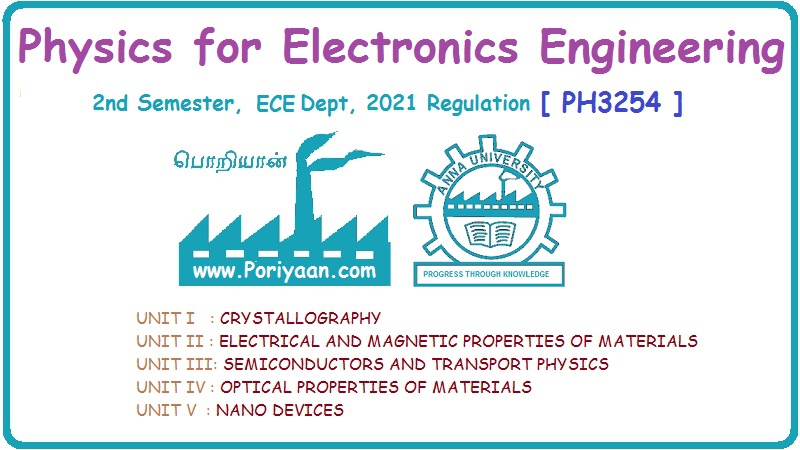Physics for Electronics Engineering: Unit V: Nano Devices
Anna University Model Question Papers
Physics for Electronics Engineering
Previous Question Papers Physics for Electronics Engineering PH3254
Anna University Model Question Paper - 1
Answer
ALL questions.
PART
A (10 x 2 = 20 marks)
1.
Distinguish between Mean free path and Collision time.
2.
Define density of energy states.
3.
What are n-type and p-type semiconductor? Give examples.
4.
Distinguish between Ohmic and Schottky contacts.
5.
Define the terms intensity of magnetization and flux density.
6.
Mention the energies involved in origin of domains in ferromagnetic material.
7.
What is recombination process in semiconductors? (d)
8.
List out any four advantages of LED in electronic display. 9. Define the term quantum
well and quantum wire.
10.
What is spintronics?
Part
B (5 x 16 = 80 marks)
11.
(a) Deduce mathematical expressions for electrical conductivity and thermal conductivity
of a conducting material and hence obtain Wiedemann-Franz law.
(OR)
(b) Explain the band theory of solids in detail and classify solids into conductors, semiconductors and insulators with neat diagram.
12.
(a) Write a note on carrier transport in n-type and p-type semiconductors.
(OR)
(b)
Explain with necessary theory the Hall Effect and the Agni experimental method
to determine the electrical conductivity
of a semiconductor. Explain any four applications.
13.
(a) What are ferrites? Describe the different types of ferrites structure with suitable
diagrams and mention its applications.
(OR)
(b)
Describe the working of magnetic hard disc based on GMR sensor. Mention its advantages
and disadvantages.
14.
(a) Explain absorption and emission of light in metals, insulators and semiconductors.
(OR)
(b)
Describe in detail, the principle construction and the xull bas working of OLED
with a neat diagram.
15.
(a) Discuss in detail quantum confinement and quantum structures in nano materials.
(OR)
(b)
Explain the synthesis mechanism and physical properties of CNTs with a neat
sketch and mention its application.
Anna University Model Question Paper - 2
Answer
ALL questions
PART
A (10 x 2 = 20 marks)
1.
What is meant by a free electron?
2.
What are forbidden bands?
3.
Define the term mobility of a semiconductor.
4.
Mention the uses of Ohmic contact.
5.
Define magnetic susceptibility and permeability.
6.
The dielectric constant of a He gas at NTP is 1.0000684. Calculate the
electronic polarizability of He atoms if the gas contains 2.7 x 1025
atoms/m3 and hence evaluate the radius of the He atoms. Given E0 =
8.85 × 10-12 F/m
7.
Define carrier generation and recombination.
8.
What are excitons? Give its types.
9.
What is meant by tunnelling?
10.
Define Coulomb blockade effect.
PART
B (5 x 16 = 80 marks)
11.
(a) Deduce mathematical expression for electrical conductivity and thermal conductivity
of a conducting material and hence obtain Wiedemann. Franz law. (16)
Or
(b) Obtain Eigen values and Eigen functions of an electron enclosed in a 3-D potential box. (16)
12.
(a) Derive the intrinsic carrier concentration for intrinsic semiconductor.(16)
Or
(b)
Explain the fabrication of the power transistor with applications. (16)
13.
(a) (i) Explain the different types of polarization mechanisms involved in a dielectric
material (10)
(ii)
Explain its frequency and temperature dependence. (6)
Or
(b)
What are the different types of dielectric break down in dielectric medium? Discuss
in detail the various types of dielectric breakdown. (16)
14.
(a) Explain the theory and working of LED. (16)
Or
(b)
Explain the construction and working of a semiconductor diode laser (laser
diode) with diagram. (16)
15.
(a) Discuss density of states in quantum well, quantum wire and quantum dot. (16)
(or)
(b)
Describe the carbon nano tubes with their properties and applications. (16)
Physics for Electronics Engineering: Unit V: Nano Devices : Tag: : Physics for Electronics Engineering - Anna University Model Question Papers
Related Topics
Related Subjects
Physics for Electronics Engineering
PH3254 - Physics II - 2nd Semester - ECE Department - 2021 Regulation | 2nd Semester ECE Dept 2021 Regulation
